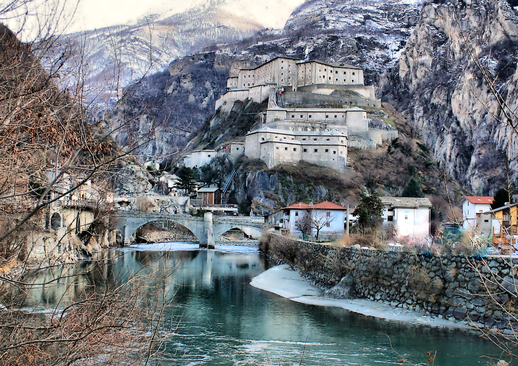Fortress of Bard
Almost intact from the moment of its construction, the Fortress of Bard represents one of the best examples of early 1800 military strongholds.
The Fortress of Bard is formed of 3 main defence stations positioned at different levels upon a high imposing rock spur, the lowest at 400m above ground and the highest at 467m. The Ferdinando Opera is the defence structure at the bottom, the Vittorio Opera in the middle, and the Carlo Alberto Opera at the top. There are a total of 283 rooms in the entire fortress.

During the Spanish Wars of Succession the resistance by Vittorio Amedeo II's army against the French troops was a memorable one for Bard. But the most famous military episode witnessed by the fortress was the seige of 1800. At dawn, on the fourteenth of May, Napoleon's 40.000 strong Armée de réserve crossed the Alps through the Great Saint Bernard Pass taking the Austro-Piedmontese army occupying the Po Valley by surprise. The invading troops soon reached Bard but were halted by the Austrian garrison defending the fortress.
During a night attack on the twentyfirst of May the village of Bard surrendered to the French forces but the commander of the fortress, Captain Stockard von Bernkopf, did not give up the battle. The French General Marmont failed in his nightly plans to transport cannons up to the top of the fortified rock and after several unsuccessful attempts had no choice but to put the fortress under siege. Finally, on the first of June, after a whole day of bombardment, Captain von Bernkopf honorably accepted defeat.
Army property, the fortress fell into disuse in 1975 and was acquired by the Autonomous Region of Valle d'Aosta in 1990.
An interdisciplinary group of experts carried out a feasibility study for the restoration of the entire fortress compound and the revival of the medieval village of Bard.
The joint-stock company, Finbard, planned and managed the restoration works and the necessary modifications for functional use.
Financial contributions from the European Regional Development Fund and the State Rotational Fund, for the regeneration of areas in industrial decline, helped realize the project.
Thanks to the restoration of this magnificent fortress and the various territories connected to it, the entire fortress compound together with the village of Bard has now become the leading cultural centre of the Western Alps, offering innovative exhibition spaces and services dedicated to the spread of culture combined with high quality accommodation and hospitality facilities.
The museums have been designed in such a way as to integrate the traditional role of the museum as an exhibition space for objects of historical, scientific, artistic and cultural interest with that of an educational one. Hence the museum becomes a creative place of exploration, interpretation and communication; a "cultural theme park" that offers the visitor a deeply absorbing experience.
For more information, see here.
